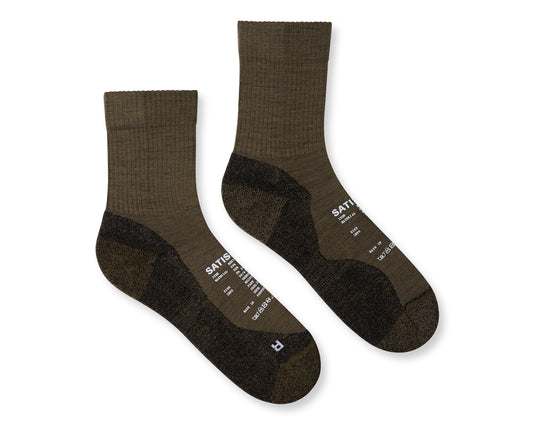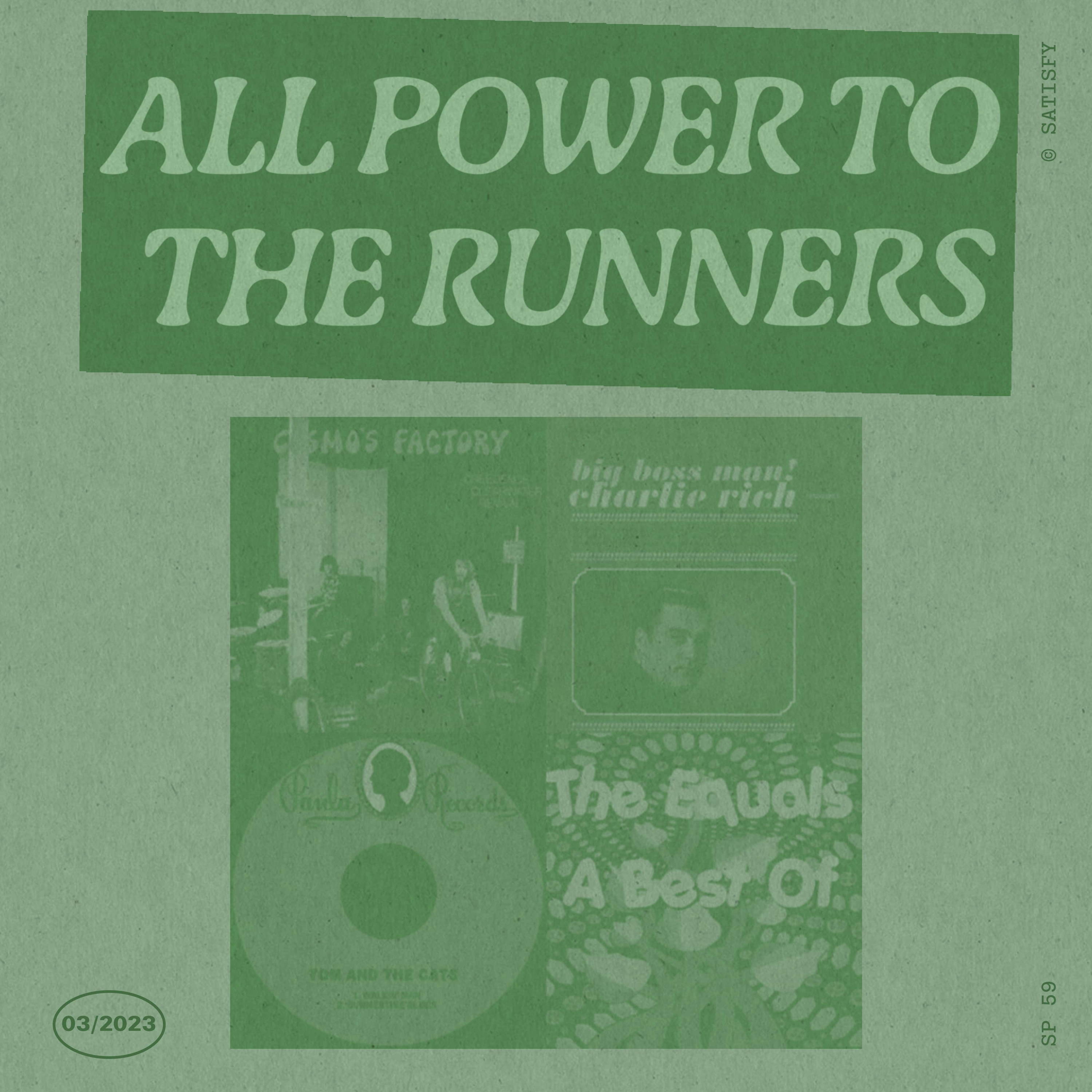
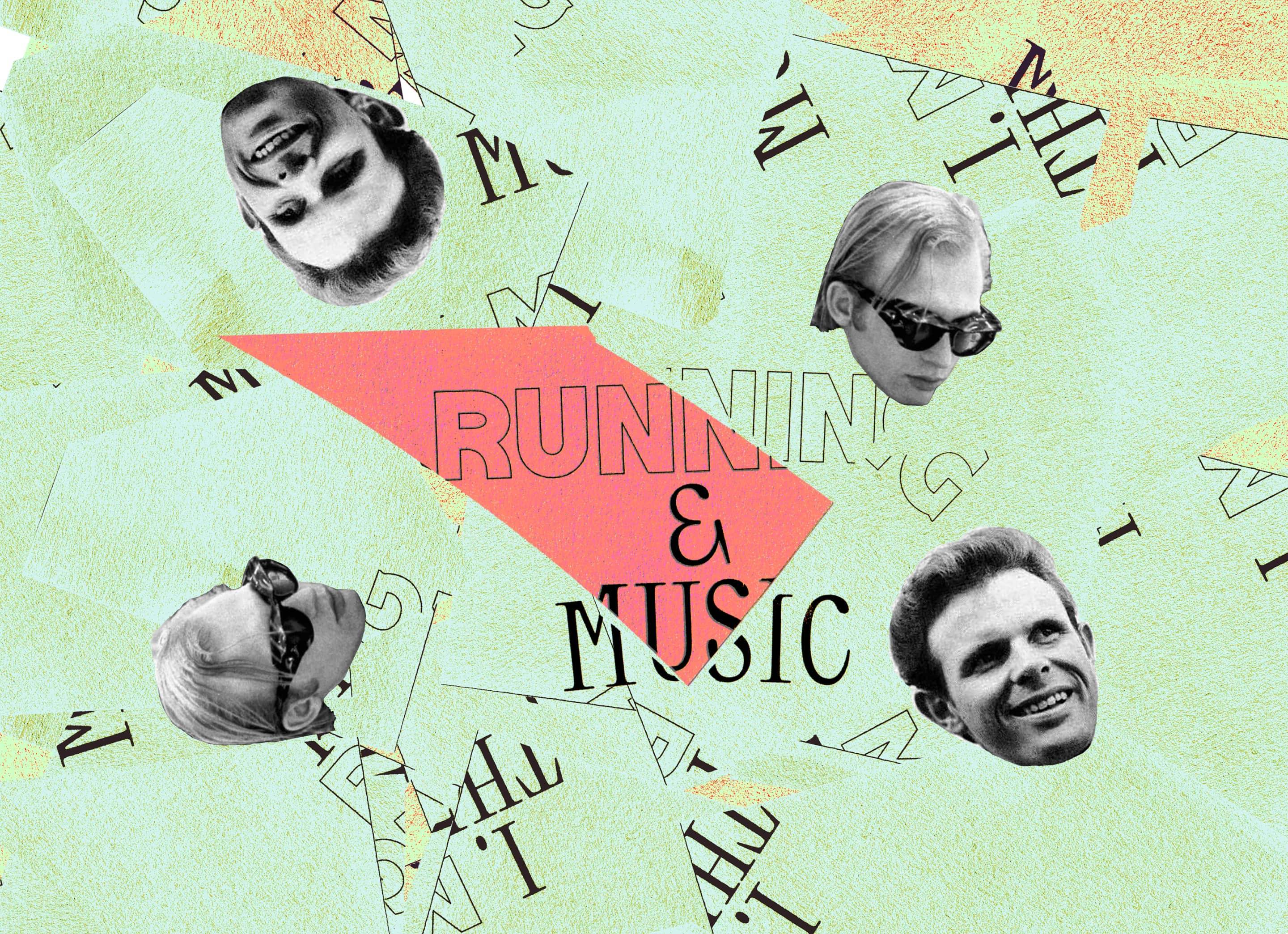
When you run, you most likely listen to music. Some runners listen to heavy metal, others prefer jazz. Some like ambient music, while a defiant few eschew music altogether, claiming it interferes with their appreciation of the environment, awareness of their breathing, and their relationship to nature. Whatever a particular runner’s personal tastes, it’s a fact that music is a huge part of the running phenomenon, particularly since the mobile “Walkman” portable cassette deck with headphone was invented.
In this issue of POSSESSED MAGAZINE, we will explore this relationship between the runner and their music.
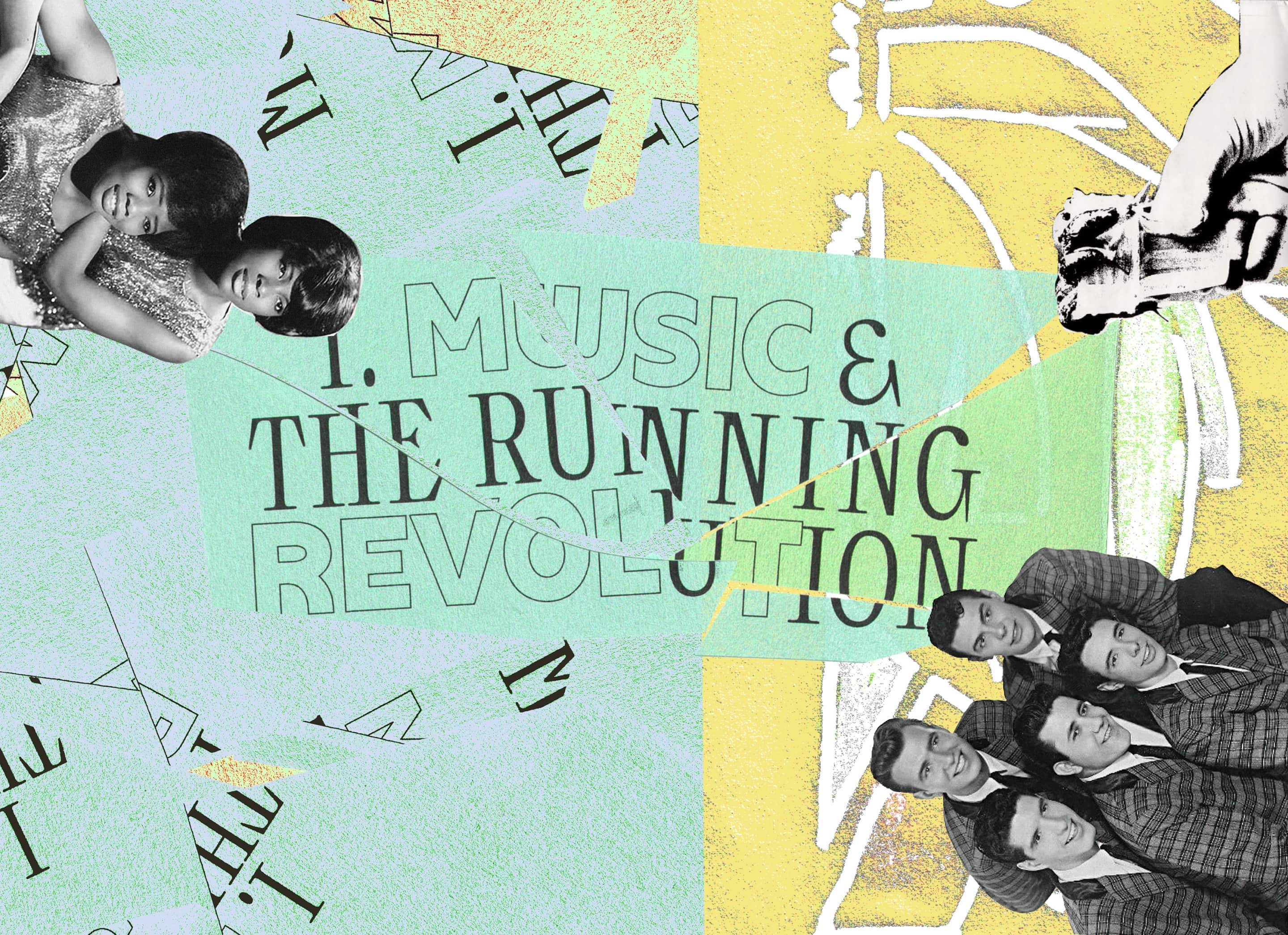
The mass running craze of the late seventies, which was spurred on by Jim Fixx’s smash bestseller, “The Complete Book of Running,” occurred in simultaneity with the advent of the first portable cassette listening devices, made by Sony, called “The Walkman.”
In fact, Jim Fixx’s evangelical role as running guru might have been a non-starter if it hadn’t been for the timely intervention of the Japanese electronics giant, who created a light mobile cassette deck that allowed its user to select their own music and that, because it had no external speaker, didn’t allow anyone else to hear. It was a device that encouraged introversion and isolation; a solipsistic, hyper individualistic musical experience, as opposed to the communal transistor radio phenomenon which had characterized the beach blanket teenage culture of the previous decade.
The Walkman —which sold in the millions— was related to the LSD revolution of the middle/late 1960s, in encouraging a particular type of individualist “trip” or experience. The user of LSD, in “dropping acid” was having their own very personal experience, as opposed to the communal inebriation of drinkers at a bar, for example, who trade stories and engage in singalongs. In fact, The Walkman phenomenon was essentially a new, electronic consumer stage of the psychedelic revolution; acid as a mechanical gizmo. The Walkman gave the user the ability to move through society with their selection of music on the one hand but paradoxically —due to the headphones and volume— precluded any interaction with it. The importance of a personal soundtrack, picked by the individual instead of a radio deejay, was tied into the ‘60s counter culture conceit of pop music as a totem of identity and elitism. The Walkman provided a tailored experience and gave the user a godlike sense of “voyeur” otherness and also made them deaf and mute in re: society and real life situations. They were “stoned... immaculate.”

Since the Walkman was perfectly suited for athletic activities such as aerobics and running —which were social but not interactive— these activities moved from being in the athletic domain of jocks and preps to being a new frontier realm in the me–generation’s self–realization hippie trip.
Woodstock was the mass popularization of the “beatnik” trend that had permeated US culture since after the war and even, arguably, since the advent of Modernism. Beatnik values were anti-authoritarian and individualist. There was a fascination with Eastern philosophy and drug use, perhaps some dabbling in anarcho-leftism, but no card-carrying commie club membership. Beatniks were weary of the idealistic and ideological mass movements that had characterized the radicals of the pre-war generation.
Once the hippie dream went sour in the cities, with the influx of CIA heroin from the Golden Triangle, the radicalization of street gangs, and the media storm around Manson, the hippies retreated into nature, building geodesic domes and creating communes. When this got tiresome, the beatnik impulse was still there but it needed a new, less utopian outlet. With the advent of the Walkman, it became clear: this outlet would be fitness and running.
Running, in its late seventies manifestation, therefore had a clear lineage to the hippie beatnik movement but its radical side was now dormant. The semi-nude aspect was retained –with the short shorts, low socks, and tank tops– as well as the naturalism, mysticism, and intimate relationship to music.
Since the Walkman’s invention of course, running audio devices have gotten much more mobile and effective and do more with less space. But the bond between running & music is as strong as it ever was.
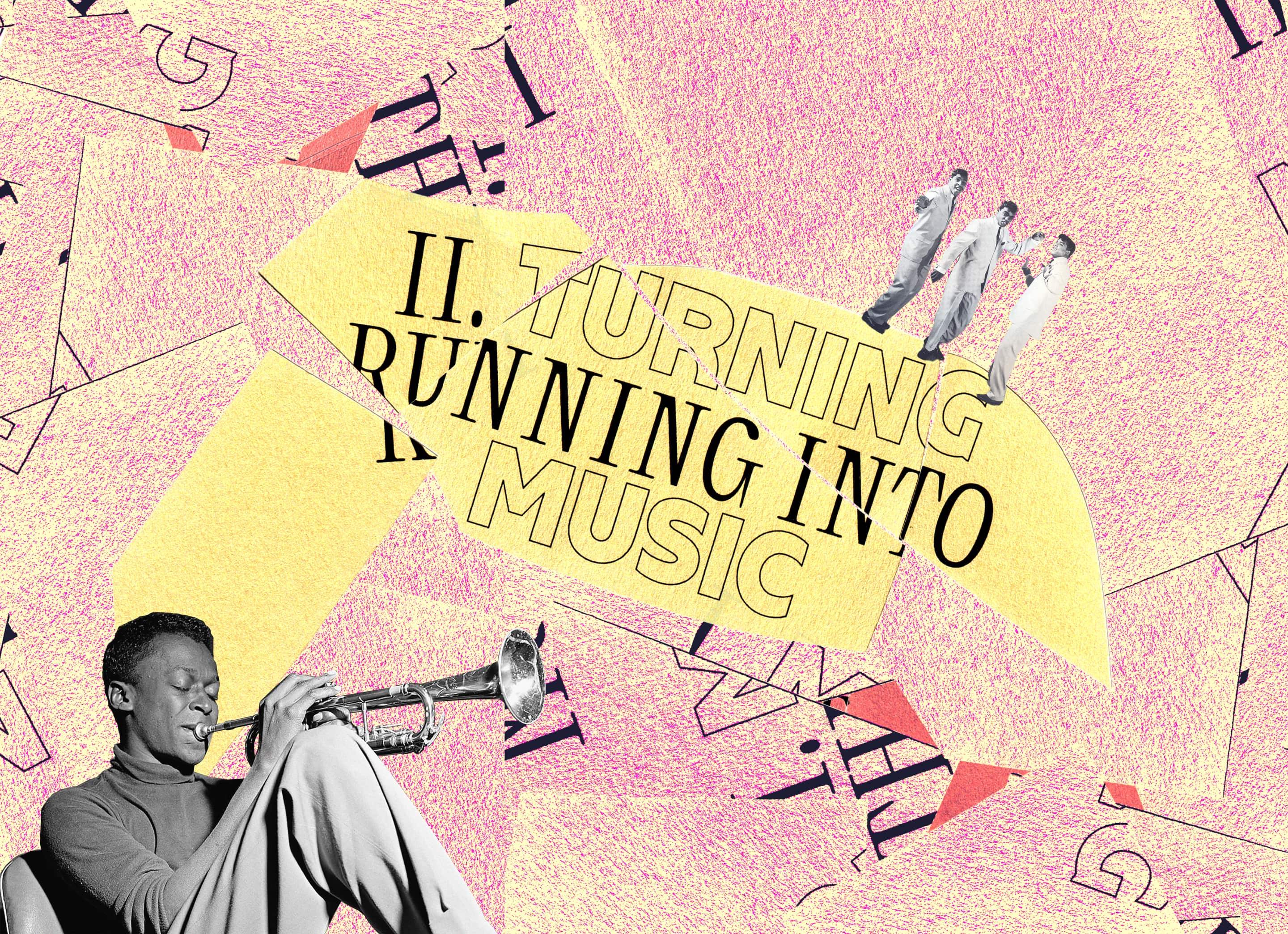
Many musicians, over the years, have professed a love of running. Joe Strummer, Johnny Marr, Miles Davis… the list goes on. The two pastimes —music & running— seem to complement one another.
“How so” you ask? Well, for example, there’s the meditative/spiritual aspect of running. When one’s brain is filled to capacity with composition, publishing contracts, music theory, and the other facets of record making, some sort of mind clearing exercise is not only desirable, but necessary.
Also, running helps the brain and body resolve their historic alienation from one another. The famous mind/body schism, pushed by western society, is a dialectic that rockers, in particular, have attempted to overcome.
Finally, running is not (usually) a “team sport”. Many music makers have an anarchic or anti-authoritarian streak, and nurse a weariness toward hierarchal, competitive, and/or rule-based activities. Running is a sport, sure, but one which can be free form and decentralized.
For these reasons and more, running is the go-to sport activity for the musician, whether they be composer, arranger, producer, session-man or girl in a band.
But, reconciling running –good for mental and physical health– and making music is sometimes difficult. With so few hours in the week, how does one make time for both?
The musician, after all, is loathe to leave their studio –unless it’s to stumble on stage for a few sweaty moments, greedily soak up some audience adoration, and collect a check. Sure, perhaps they’ll pop out for a quick rendezvous with a “muse” or to meet up with a narcotics dealer. But, typically, musicians prefer to hide away in some basement studio Xanadu, where they endlessly pore over some “mix” or re-record a glockenspiel solo for the hundredth time with some equally off-ish gear freaks.


Life in the recording studio is one where time melts away. There are no clocks, and weeks often stretch into months, as the mini-Mozart of the moment makes their masterpiece, fiddling knobs in an interminable, quixotic quest for perfection. This kind of hermetic studio routine does not for a healthy lifestyle make, and the high mortality rate among rockers is due more to this —and the take-out food and hunching over that characterizes it— than the heroin and speedballs typically cited as “cause of death” when a star suddenly expires. If the rocker had been exercising regularly and eating fresh vegetables, they could have taken all the drugs they wanted with little or no consequence.
Since the specter of death is constantly looming over the musician’s shoulder, exercise –and, most commonly, running– is increasingly recognized as a strategy to keep the reaper at bay. This approach is, of course, controversial. While the record company is gambling on the artist’s early death –always great for sales– the artist’s management needs their clients to survive so as to ensure continued employment. Management loses big time when a star dies, while the record and publishing companies win big. Therefore, while the label honchos encourage nihilism, their manager is more conservative, urging their clients to do yoga, jog, drink juice, etc. And many do.
It’s not surprising that music types take to running. Of all the exercises, running allows for a little dignity, in contrast to fitness fads like “cross-fit” or the other nonsense on offer at the gym.
The classic and staid elegance of running, along with a concern of management for cheating death, is the principle factor accounting for more and more musicians taking up the pastime. What’s resulted is a running path lousy with cult stars and crash & burn hellcats.
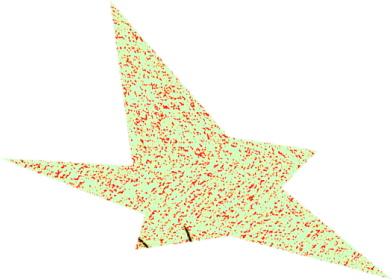
The classic and staid elegance of running, along with a concern of management for cheating death, is the principle factor accounting for more and more musicians taking up the pastime. What’s resulted is a running path lousy with cult stars and crash & burn hellcats. The running track has become a see-and-be-seen hot spot for rock ’n’ roll’s leather and long hair types, who can be spied talking shop, making deals, and trading tour pointers whilst stretching on the grass by the public restrooms. Of course, these ne’er do wells are hard to spot at first, but those in-the-know can identify them by their particular trendy gear: Satisfy® brand sweat-soaked headband, de rigueur Italian shades, and tight, slightly risqué Satisfy® brand running shorts. Though musicians are fond of running, there is a little frustration amongst them in regards to the time commitment required by their newfound physical pastime. Many wonder aloud if there is a way to combine their two passions: running & music making. And indeed now, for a quickly growing avant–garde, there finally is.
More and more music makers are engaging in a practice called “running music”; composing and performing music, not while running, but through the act of running. Though this seems preposterous and even a little sacrilegious, in today’s production obsessed economy, where time = money, it’s just what has to happen. But, one may ask: how does one compose and play while running? After all, singing and playing an instrument are almost impossible to do while one tears down a path in a park or through a city street. And holding and playing a clarinet, a tuba, or an electric bass guitar would be extremely difficult to pull off on, for example, a 10k run. Even singing is hard. One’s breathing during running is inconsistent both with the melodic, full throated singing required by “pop” and the screaming, growling, and yelping necessary for metal and punk.

Despite these seeming limitations, more and more running musicians are composing music whilst running. How do they do it?
Well, rhythm of course is the consistent component. Stomping feet are one of the foundational aspects of “roots” i.e. rock, country, gospel, folk, and soul music. Almost all of the most venerable and beloved songs were initially composed with nothing but stomping feet. Yes, before banjos, fiddles, and tambourines were available or affordable, people used their stamping feet. And –coincidentally– running is also based on the stamping of feet. When one runs therefore, one is inadvertently making music. Listen to the sound of your feet as they stomp out a song on the pavement. It’s mesmerizing. And catchy. You’re a genius. No, seriously; you’re really good. Your foot stamping “song” gives new meaning to the term “hit parade.” And, there are endless possibilities. The outdoors is your orchestra. Listen: When one switches running surfaces, the sound changes. This is akin to a key change or, perhaps, like stepping on a fuzz pedal.
John Cage would be proud of you for utilizing your environment and making music out of raw materials. But, you needn’t be content with making just a simple percussive song based on the stamping of your feet. Polyrhythms are possible in one’s running composition, particularly if one runs in a group, as many musicians do. Orchestrate the rhythms of the different runners to augment one another, to run counter to each other, to lope, to hop, etc. Someone can “solo” run whilst everyone else halts. Applied use of different feet will provide rich and varied possibilities for your rhythmic composition.
And it’s not only rhythm that’s available; one can also conduct one’s environment. Try to summon sounds. The way a conductor reaches out their hand and commands the timpani, so can you invoke sounds from your environ. For example, if one runs near traffic, there will inevitably be horns. Honking. This could be like the lead guitar over your foot stomping rhythm. You could run in front of an oncoming car to summon the horn blast at the moment of crescendo. Then, there could be a siren: commit a crime –perhaps the smashing of a store window whilst you run– and this siren noise will be assured. Integrate it into your composition at a good strategic time to best enhance the song. Utilize the obnoxious noise of a helicopter; helicopters are drawn to news events. Create a news event –robbing a bank for example– and, voila! There’s the news 4 helicopter in your orchestra which serves at your pleasure.
Police helicopters are tax payer financed so summoning them gives you a chance to create publicly funded art. The people’s art! This is the only legitimate art, as opposed to the money laundering charade of oligarchs and country club debutantes referred to in polite society as “the art world.” Dogs baying in the distance, train whistles blowing, construction cranes laying waste to beautiful historic buildings, commuters grousing; all of these environmental essences can be blended, just so, in your running music cocktail. And, with the technology of the modern age, you can record all of it.
Music from the studio might soon be extinct as this environmental street running music takes sway over the populace, bored as hell as they are of idiotic performances in alienated arenas performed by out of touch rockstars who demand enormous fees even for nosebleed tickets. Pure exploitation is what audiences are inured to, which they accept like sheep to the slaughter since they know nothing different.
Until now. When they see you, dressed in Satisfy® brand running wear, looking sharp as a tack and orchestrating your environment whilst defiantly stomping your feet on the pavement, they’ll throw their balcony seat tickets away, start a riot, join in on the foot stomping, and pledge fealty to your phenomenon. You will be the star of a new genre, a genre that delivers where punk’s rhetoric of populism flopped. Viva la street running music!
Pure exploitation is what audiences are inured to, which they accept like sheep to the slaughter since they know nothing different.

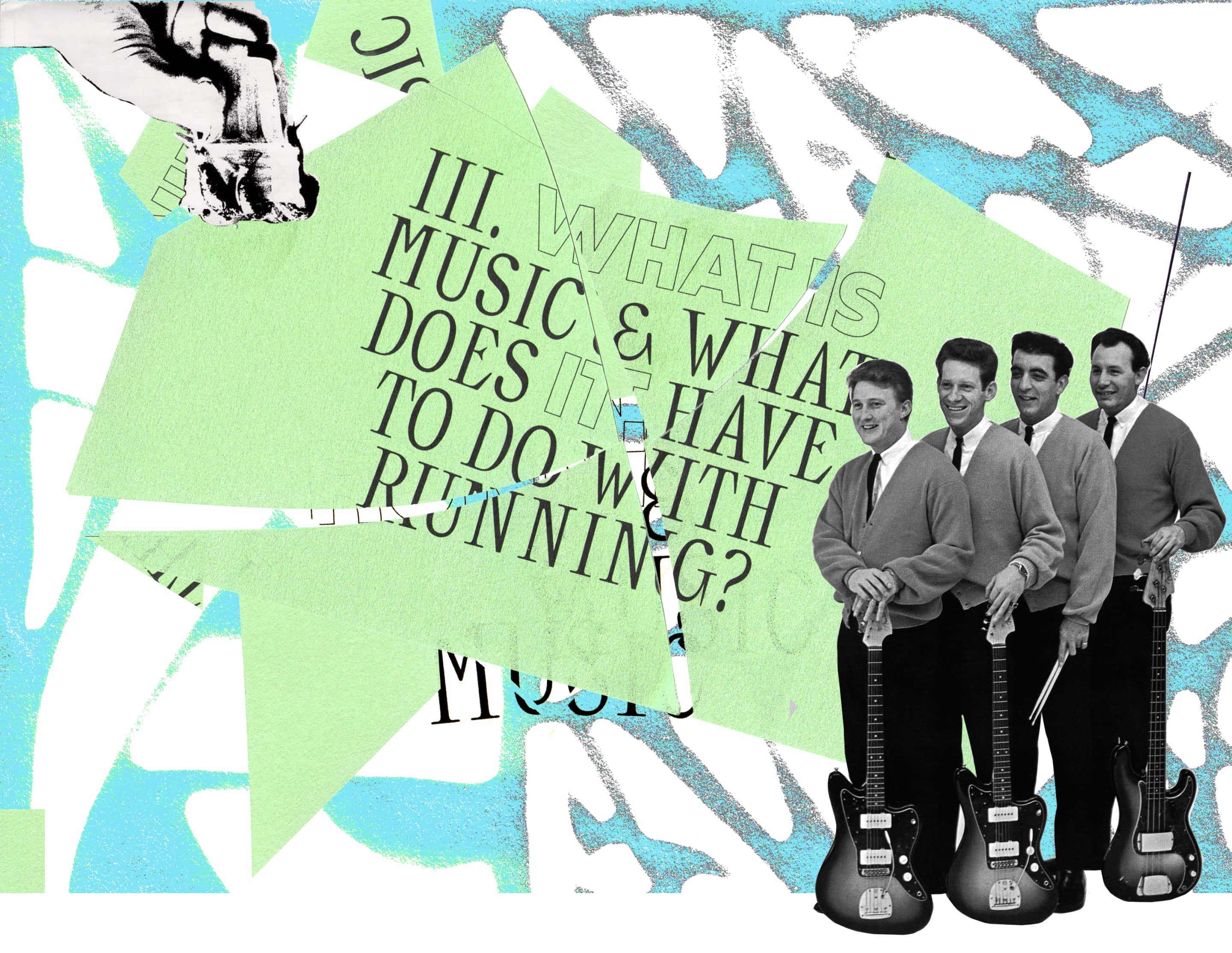
Since we have determined that running & music are absolutely connected, as runners, we must consider “what is music?”.
WHAT IS MUSIC?
Music is noise, which has been civilized through regimentation. Some call music “organized noise” or “regimented sound”. Simply put, music consists of sound vibrations which have been tamed and made to submit to humanity through rigorous and cruel “decibel discipline”. Just as a wild beast can be transformed into a domesticated pet or work animal through training, so can ordinary noise be tamed and made into music, useful to man.Essentially, music is sound –which was once wild– but which has been brought to heel and civilized.
Music making
is a war on the natural order of sounds.
BEFORE MUSIC
Before normal sound is painstakingly arranged into “music,” it’s darting pell mell through space, in a kind of chaos. Birds chirp, a car drives by, a babe cries out in the distance. Helicopters roar overhead, a kettle blasts, newscasters vomit forth their master’s propaganda. Meanwhile, the wind blows and the boughs creak. Each of these noises rub against another, vying for primacy in the turgid morass of babel; none of the noises in this cosmic cacophony seem to regard each other. And none of these sounds could be called music.
Music, on the other hand, is organized, arranged, and tuned just so. Sounds are placed carefully next to one another and then divvied up into “songs.” These are placed painstakingly onto “albums.” But the sounds which constitute these songs, records, music, etc. though they might seem singular and precious, are actually just normal noises found in everyday life. Music is just sound which has been captured, disciplined, and and compelled to adhere to society’s desires, needs, and expectations.
It’s been put to work to make money, to be utilized as pacifier in a department store, or to insidiously control the population through lyrical “messaging.” Its usefulness cannot be overstated.
IS MUSIC NATURAL?
Indeed, music is the primary component of culture or human society. Before anything else, there is music. Music for ceremony, ritual, work, religion, shopping, selling, and celebration. Mankind’s thirst for music is one that cannot be slaked. Like speed freaks cleaning house, humans are incessantly reorganizing sound to create new “songs” and new modes of “music” out of old sounds and music.
All of this taming of the natural order could be seen as a war against nature.
Music making is a war on the natural order of sounds. And it’s a tough struggle. Often times, a noise seems absolutely oppositional to anything that could be considered “music”. And yet, somehow humanity manages to fashion it into a cathy tune with a bewitching melody.
Like the thousands of nameless, faceless workers who forged raw iron ore into the Brooklyn Bridge, workers in Memphis (called Booker T & the MGs) somehow bashed some random, theretofore useless electronic vibrations into “Green Onions”.
Why all this struggling? Why not just enjoy noise and sound as they are given to us, by nature and technology? Why the dissatisfaction with the the way things are?
Because music is necessary. Music serves a function. The principle use of music of course is to give runners something to run to.
Time to wake up. Enough is enough. What is needed is a runner’s union. A union of runners who can petition for their compensation.
THE FUNCTION OF MUSIC IS TO CREATE RUNNING
At the dawn of humanity, someone beat a drum or something that resembled a drum or made a drum-like noise. The energy it produced induced the people to run.
Before this, people were sloth-like and lazy. The rhythm was quickly deemed to be the essential ingredient to the runner running.
Through running, the human was able to catch its prey; the rabbit or whatever it was they were chasing. The people who could run easily bested those who didn’t. The non runners died out; were conquered/ phased out/ made redundant. Non-runners were made extinct. But those who ran always unconsciously remembered what had spurred them to run; they knew that it was a slippery slope back to primitivism and that regression was always possible without the music. The music was what had brought them out of the mire. Therefore, music was holy. It was institutionalized and made compulsory. This is why it is culturally omnipresent, inescapable, and so often tied to running.
Music production became the preoccupation of mankind. Creating rhythms and melody for running and production. It’s never ceased since it began, this obsession with making music for greater production. As people become inured to one music, invention of another genre or type of music is necessary so as to keep humans running.
The principle use of this “music” production is to give runners something to listen to.
Without music, running is difficult. The body heaves and the legs threaten to collapse. The heart beats wildly and perspiration flows from the pores in uncontrollable streams. Without distraction of melody and lyric and without the martial beat exhorting the legs, failure is foregone.
And this must not happen. The runner’s production is vital for the society to continue. The runner isn’t a simple exercise nut, just concerned with beautifying the body. The runner’s example is what makes the cars drive, the lights go on, the smokestacks of industry bellow forth their noxious smoke. The runners are, in fact, what keeps society —always on the verge of collapse— from breaking down . The runner, a kind of human bee, serves to cross-pollinate society. The runner knows not why they run. They do so from an unconscious compulsion to do so. Their example, as active specimens, their perspiration, heaving chests, and pheromones, spread environmentally far and wide through their strange ritual of running, is what keeps society fecund. Just as the fertility symbols which once littered pre Christian society exhorted mankind to procreate even in times of famine and depression, so does the runner inspire others to work harder, try harder, and be better. Therefore, all sorts of technology has been devised to keep the runner running. The principle technology is, of course, music.
Early on, the runner ran to the beat of a drum, often in times of war. The tom-tom tattoo invigorated the runner, increased the pulse rate and blood flow and led them to victory. Inevitably, the tom-toms were discarded for the Walkman cassette player with headphones. Now, the runner uses a digital player of some sort. The music is a tool to enhance productivity in the runner-worker. Since the runner is a vital cog in the industrial machine, and the essential ingredient required for society to succeed, shouldn’t runners be compensated? Otherwise, it’s just pitiless exploitation. Time to wake up. Enough is enough. What is needed is a runner’s union. A union of runners who can petition for their compensation. And if they aren’t compensated, they must strike.
We need a runner’s union who will hold a runner’s strike. The primary tools for labor victory are already with us. The work stoppage. We stop running/working; society breaks down. The sit down strike. We stop running and sit down. Society grinds to a halt. Our greatest threat to the power structure would be to stop running. They would never countenance it. We have them where we want them. All power to the runners.
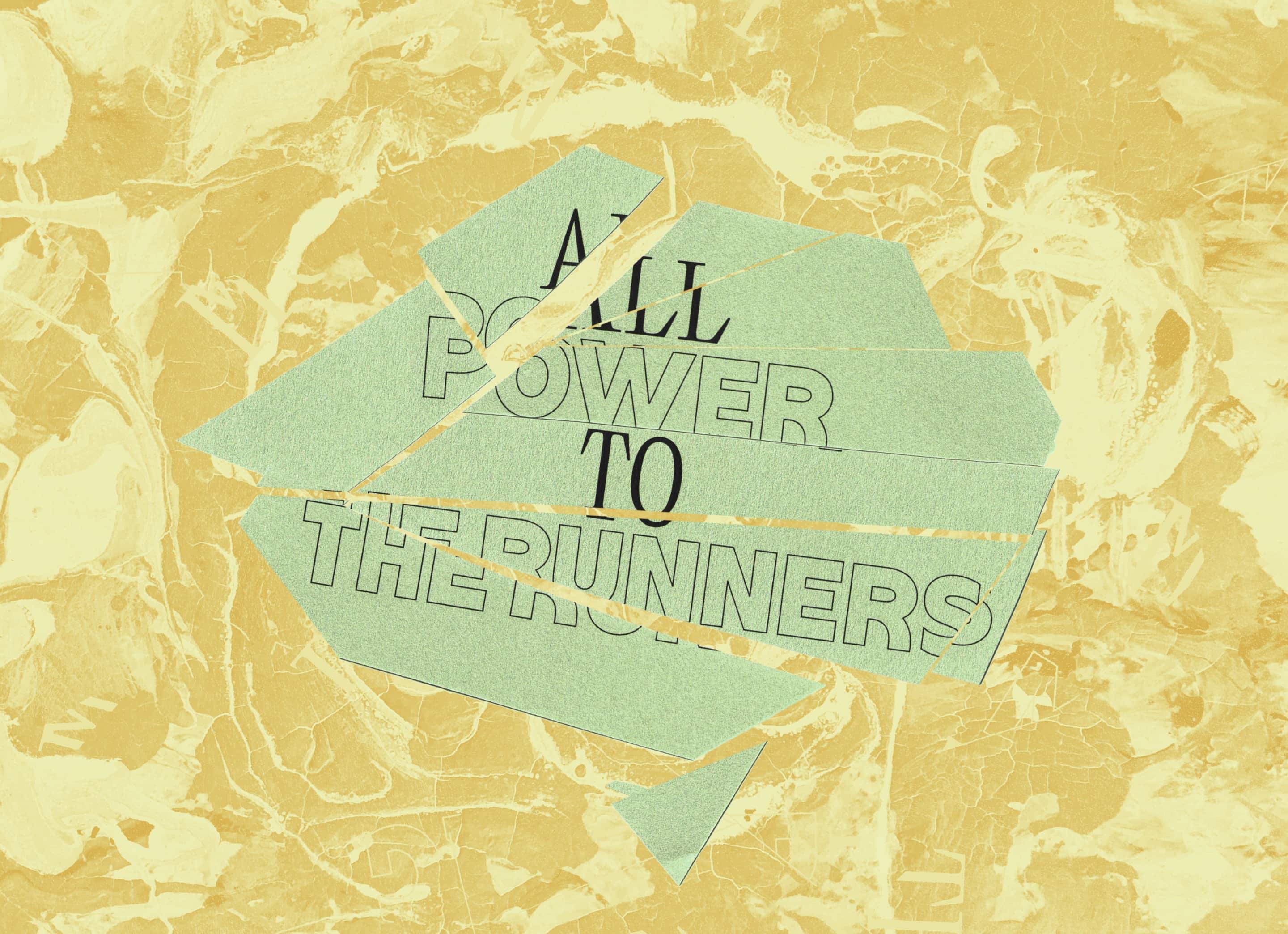
The Playlist
By Ian F. Svenonius
Editor-in-Chief: Ian F. Svenonius
Artwork and Layout: Jaakko Suomalainen
© POSSESSED MAGAZINE



